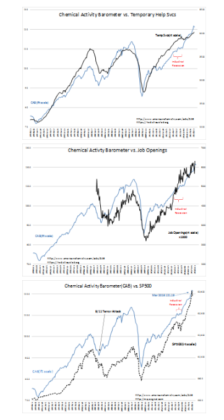“Davidson” submits:
Chemical Activity Barometer(CAB) is reported at 121.19 which represents a short pause after strong period of rise. The CAB, introduced in 2012, is not well known. It has been calculated to 1919 showing it to be an excellent indicator of economic factors influencing market prices. Shown are the CAB correlations to Temporary Help Svcs, Job Openings and the SP500. The CAB trend follows closely on the heels of Temp Help trend and leads the trends in Job Openings and the SP500. In particular the CAB indicated economic recovery had begun the same month as the 9/11 attack on the World Trade Center. While market psychology drove market prices lower on the event and the next 12mos, the CAB indicated that an economic recovery had begun Sept 2001 and continued with little interruption. The lesson to learn is that market psychology drives market prices short-term, but it is economic activity which drives market psychology and market prices long-term.
“In Like a Lion: Leading Economic Indicator Logs Strong Year Over Year Growth; Marks Sixth Consecutive Gain”
https://www.americanchemistry.com/Media/PressReleasesTranscripts/ACC-news-releases/In-Like-a-Lion-Leading-Economic-Indicator-Logs-Strong-Year-Over-Year-Growth.html (CAB 3mo moving avg is what American Chemistry refers to in this title. The charts use monthly data)
“Applying the CAB back to 1912, it has been shown to provide a lead of two to fourteen months, with an average lead of eight months at cycle peaks as determined by the National Bureau of Economic Research. The median lead was also eight months. At business cycle troughs, the CAB leads by one to seven months, with an average lead of four months. The median lead was three months. The CAB is rebased to the average lead (in months) of an average 100 in the base year (the year 2012 was used) of a reference time series. The latter is the Federal Reserve’s Industrial Production Index.”
The Investment Thesis:
The trends in the CAB, the Temporary Help Index and the Job Opening Index provide significant support for higher equity prices. The US tax cuts and the significant cuts in regulations with more promised provide support for expecting a multi-year continuation of the current global expansion. Equity prices typically follow economic trends with a lag 6mos-12mos.
